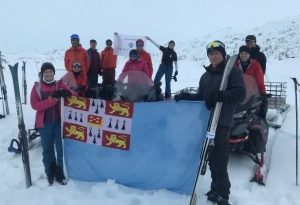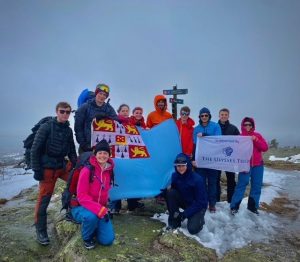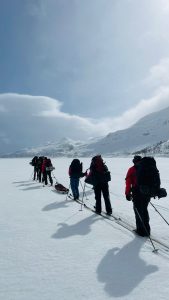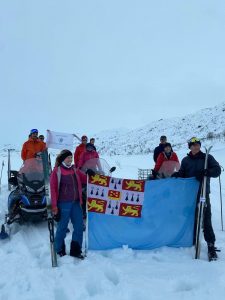After a hearty pre-exped dinner enjoyed whilst watching the 1965 ‘Heroes of Telemark’ starring Kirk Douglas, Second Lieutenants and three Officer Cadets set off from Cambridge ARC and headed for the Hardangervidda plateau, Norway, on 31 March 2024. Having explained our official NATO Travel Orders to a bleary-eyed French border officer, convincing him that we were indeed part of the British Army, and pleading with him for no ‘stampy stampy’, we continued on our 20-hour Combi-van journey. Two days and five countries later, we picked up the remaining five OCdts, two Second Lieutenants and two Nordic Leaders (Captain Atkinson and Corporal Bell) from Oslo airport, and so commenced Ex. DRAGON TELEMARK BLUE. What follows is a condensed summary of an expedition that was, in several Officer Cadets’ words, ‘the adventure of a lifetime’ which not only introduced over a dozen of the British Army’s future leaders to Nordic skiing, but consistently pushed their mental and physical resilience to the limits, all whilst putting them in the shoes of the 1943 SOE saboteurs. At a time of financial cutbacks, this expedition simply would not have been possible without the Ulysses Trust’s very generous support, which all participants will remain consistently grateful for, when looking back upon this formative experience.
The Expedition:
Ex Dragon Blue Telemark was a two-week Level 3 Nordic Skiing exercise and battlefield study following the original route of the Op. Gunnerside SOE saboteurs, taking place between 1 April and 14 April 2024. In total, eight Officer Cadets and four Second Lieutenants took part in the expedition, every single one of whom was a student Army Reservist and member of Cambridge University Officers’ Training Corps. With no permanent staff accompanying us, upon leaving Cambridge Army Reserve Centre on the evening of 31 March, the expedition was completely student-led and supervised. Our aim was to introduce Officer Cadets to Nordic skiing by recreating the audacious raid undertaken by SOE-trained Norwegian commandos in the winter of 1943, who successfully used the freezing Hardangervidda plateau as a point from which to sabotage Nazi heavy water production in the town of Rjukan – entirely derailing Hitler’s atomic bomb project.
We achieved these aims thanks to the guidance of three dedicated and experienced Nordic Leaders; Captain Michael Atkinson of 32 Engineer Regiment, Lieutenant RN Jason Franks of HMS Ferret, and Corporal Jamie Bell of 1 Mercian – who, having recently passed his NL1 Course, was instructing for the first time. That this ambitious and student-led expedition took place is thanks to the selfless commitment of these instructors, everyone at Cambridge OTC, and crucially, the generous support of the Ulysses Trust.
Foundation Days:
Days 1-4: Mastering the Basics in Evje
Having arrived at our accommodation the previous evening, 2nd April was our first full day as a group, and we made the most of it by loading into the combivans and transporting to the nearby Høgas ski centre to begin our NF1. For most Officer Cadets and Second Lieutenants, this was their first experience of Nordic skiing, and for two OCdts their first foray into any form of winter sports. After equipping ourselves with loan pool kit, we clipped in, split into two groups led by Captain Atkinson and Corporal Bell, and took our first enthusiastic glides along the freshly cut snow. Although we hadn’t seen much snow on the drive up to the training area, upon arriving we were delighted by the conditions – fresh, powdery snow, on a clear high visibility day.
Snowfall was regular and plentiful, and these conditions generally persisted for the next six days, making our NF1 course a dream. We rapidly developed under the watchful eyes of our Nordic Leaders, mastering the basics: weight transfer, pole placement, kick and glide, turning, and descending and climbing gradients. The NF1 curriculum however required more than just these skills, and each evening, after cooking up a hearty communal meal, we attended lectures given by Captain Atkinson on the importance of Adventurous Training to the Army, safety procedures, avalanche survival skills, route planning, navigation, and several other skills essential to the curriculum, and to our expedition. As the head of the Royal Engineer’s Winter Sports team/initiative/training, we were extremely fortunate to receive these lectures, as well as practical teaching from Captain Atkinson, who had an outstanding wealth of operational and recreational experience of Nordic skiing and arctic survival.
Days 4-7: Building on NF1
With the help of our instructors, as well as the input of the three expedition members who had previously Nordic Skied, by the end of the first four days, everyone in the group was confident on their skis and satisfied the criteria needed to complete Nordic Foundation 1. It was now time to prepare ourselves for the expedition itself. We did this by progressively increasing the distances skied, carrying weighted bergens, demonstrating advanced techniques such as skating, and crucially by practising our hut routine and avalanche survival skills. Although some Officer Cadets were disappointed not to get the chance to bury one of their colleagues and then dig them out, as Captain Atkinson claimed he had done on his NL course, all were glad to finally put the transceivers, poles, and shovels to good use in a simulated avalanche exercise – building our confidence with the kit, as well as teaching us crucial survival skills. Conditions in this phase were sunnier – although as we learned, this was not necessarily a positive. Snow turned to slush, and with it our ability to ‘glide’ with our skis was impinged. Though frustrating at the time, especially as we struggled up hills with fully packed bergens, we soon came to appreciate it as good experience for the expedition itself, where consistent conditions were by no means guaranteed. Additionally, the weather helped hammer home our instructor’s briefs on layering. Whilst we had started off clad head to toe in enough warm kit to make Roald Amundsen blush, by the end of our training phase we were skiing off-piste in nothing more than t-shirts and waterproof shells.
As before, this training was complemented by evening lectures, presented by Captain Atkinson. In the space of just a few hours of lectures, Captain Atkinson communicated over three decades of his Nordic Skiing experience, preparing us for our imminent expedition across one of the harshest habitats that Europe has to offer – the Hardangervidda plateau. Our learning was not however entirely instructive, but instead, as befits a battlefield study, we were fortunate enough to receive lectures from Brian Desmond, our local fixer. As a former Royal Marine Commando, GB skier, biathlon champion, consultant for the Dutch special forces, aide to Ray Mears, local politician, and friend to the original Norwegian saboteurs, Brian was unsurprisingly qualified to deliver engaging briefs on the daring raid that we were recreating, teaching us a huge amount of respect for their conviction and commitment to delivering a sabotage that crippled the Nazi atom bomb project. Not only did Brian’s lectures sober us up to the realities and challenges of operating in the Hardangevidda, but they were additionally successful in unnerving our own team historian, 2Lt Friend, who soon feared for his own job security (and additional RSDs).
It was against this backdrop – of long days skiing, followed by evenings transcribing lectures – that we completed NF1 and NF2, and prepared ourselves for the expedition.
Expedition Days: On the Hardevingga
Day 1: Following an early start, and one final breakfast fry-up, we pushed off to begin our expedition along Op. Gunnerside’s route. With combivans full of enthusiastic, if slightly bleary-eyed, Second Lieutenants, OCdts, and instructors, we drove from Evje to our RV, where we met up with Brian, his local guides, and our new instructor, Lieutenant Jason Franks (RN). From here, we loaded ourselves and our bergens onto trailers tugged by skidoo snowmobiles, and prepared for what we all knew to be an epic one-hour insertion across the frozen plateau. Wearing as many layers as we had, we settled in and enjoyed the bumpy ride, sliding across snow-covered mountains, down into sweeping valleys, and eventually over the thickly frozen lake itself, all whilst snow fell heavily around us. For myself, the novelty of this snowmobile insertion wore off after approximately 40 minutes, when my first set of gloves became soaked through. Spirits were however greatly lifted by 2Lt Selway, who having managed to lash a bugle to his bergen, gave us a rousing performance from the rear seat of the snowmobile – much to our driver’s confusion and eventual amusement.
Arriving amid a light snowstorm, we were quick to unload our skis and bergens, assemble a hasty photo in front of the snowmobiles, before waving goodbye to our Norwegian drivers and Brian. Then, it was just us, alone on the Hardangervidda and with four days of skiing ahead of us. We made haste and took the first steps – or skates – of what would be the most visually stunning, mentally challenging, and physically exhausting adventure that any of our party had undertaken to date.
Fortunately, this first date was a relatively light introduction, with just 15km of skiing towards our first hut, or ‘hytte’ (as they are called in Norwegian), where we would spend the night. It was not without incident however, as the pulk/sled seemed intent on pulling us backwards, whilst one of our Nordic Leader’s legs fell ¾ of the way through the snow. All was forgiven and forgotten once we arrived at our hytte, which, with two separate lounges, two stoves, two woodburners, and two upstairs bedrooms, was luxurious by anyone’s standards. Upon arrival, we sprang into action by dispatching work parties to collect snow, another to melt it, and another to prepare two roaring fires. Soon enough, we were stripped down to our base layers, sweltering away inside as we dried our socks, played cards, and experimented with various combinations of ration pack ‘screech’ sachets. And although there were various complaints of snoring and sleeptalking, the vast majority slept like logs.
Day 2
Crawling out of our sleeping bags into a hytte fifteen degrees cooler than how we had left it the previous evening, we were understandably keen to layer up and get on our skis. After completing the remainder of our hut routine – preparing a fire for the next visitors and signing our names in the guest book we were again on our way. We made a short descent down onto the lake, and began skiing the approximate 20km from Berunuten Hytte to the Roleholet & Rjupehytta Hyttes
The day began perfectly, cutting fresh tracks into the powdery snow that blanketed the frozen lake that provided the gentlest route to our destination. For several hours, all that we saw was seemingly unending white vistas, surrounded by looming mountain peaks. The only signs of life were occasional tracks left by Arctic Foxes in pursuit of their prey. Conditions however took a turn for the worse as we ascended out of the lake and began climbing a succession of hills. Here, Officer Cadets and Second Lieutenants alike had to do their best to restrain their Alpine skiing tendencies, choosing to safely and slowly cut across gradients rather than bomb down them carrying some 30kg of equipment. This triggered the first of very many falls as well as attempts to stand back up again without causing too much of an embarrassing raucous. Just as we thought we had put the worst behind us, an unexpected snowstorm rolled in, resulting in whiteout conditions as we struggled towards our lunch spot. Visibility was down to 20m or less and’ with every fall, morale flagged. Fortunately, there were no injuries aside from several soggy bottoms, and our spirits were easily buoyed by a lunch of cold ration packs and Norwegian Kit Kats.
Following a succession of navigation checks – not assisted by one 2Lt producing a compass case that was missing its compass – we were soon back on track. The day was long, cold, and arduous, but we got through it. And when we separated into two groups and pushed off into the two hyttes, we embraced them as if they were Hilton Hotels, scurrying off to clear paths to the outhouses and prepare a warm dinner.
Day 3
Following a hasty ration pack breakfast and a critical replenishment of our water supplies, our two groups reunited and began anew for the third day of our expedition. As we skied along, more signs of life began to appear. Including the ‘reindeer’ moss that the wartime saboteurs had survived off as their supplies dwindled and they desperately searched for sources of food in this barren and unforgiving environment. Despite several OCdt’s enthusiasm to try this local delicacy, JUO McDermott, our expedition leader, made a wise judgment call to forbid it and move on. The day that followed was another gruelling 20kms of skiing up, and then down, slopes with the sun beating down and turning our snow to slush, and therefore forcing us to trudge rather than glide to our destination. Whatever complaints we did have however were soon silenced by our team historian pointing out that it was on this stretch of the journey that one of the Norwegian saboteurs had fallen through the ice and into the chilling waters of the lake below us. As we continued on, we were careful to alternate the pulk – our sledge full of group kit such as spare skis, additional safety kit, etc – between all members of the expedition, giving everyone a chance to challenge themselves with extra weight, as well as sharing the burden across the team. As per the previous days, morale was kept high by a succession of increasingly ridiculous falls, and even more embarrassing attempts to stand up again.
It was therefore in high spirits that we concluded our third day of skiing, arriving at Hytte, where we were to spend the remainder of the afternoon and evening. This was a particularly memorable stop, as not only was it to be our last time in a hytte together, but it was also one of the original huts that the 1943 Norwegian saboteurs had hunkered down in before launching their attack on the Nazi powerplant. Given its historical significance, we were naturally extremely grateful to its current owner – the current Norwegian Minister for Defence – for allowing us to stay there.
Day 4
By this stage, our morning hut routine was instinctive, and we quickly pushed off for the fourth and final day of our expedition. Conditions were good, and our packs were noticeably lighter without four days of rations in them, causing everyone to try and make the very most of the day by demonstrating as many NF2 techniques as possible. However, as we crossed dams, saw power lines above, and civilisation slowly came back into sight, we could not help but be somewhat sad to be approaching the end of so epic an adventure. This was perhaps best illustrated by the pings we received from our mobile phones as they reconnected to service and our loved ones’ texts came flooding in, which, though appreciated, made us reflect on how tight-knit we had become as a team in the absence of any outside information. As we skied on, our barely marked routes covered in heavy blankets of snow, slowly gave way to more well-trodden paths, and just after lunch we spotted another person – for the first time in four days.
Irrespective of previous ski experience and fitness levels, by the final day every single one of us was aching, and therefore whilst we were sad to leave the raw wilderness of the Hardangevidda behind, we were all happy to take our final glides and be met by Brian Desmond. After unclipping our skis, stripping off our bergens, and falling asleep in the combi vans, we awoke in Rjukan – our final base. Here we took advantage of the local spa, administered ourselves and our kit, and fuelled up for one final adventure.
Day 5
Though we were freshly showered, shaved, fed, and rested after our night in Rjukan, neither the adventure nor the expedition were over yet. On our final day, we recreated the final attack route of the Norwegian saboteurs, following their steep descent into Rjukan valley to avoid German defences, before climbing Gaustatoppen to attack the infamous Vemork hydroelectric power plant. Once again, thanks to the efforts of Brian Desmond, we were able to don Norwegian Army snow ghillie suits, adding an element of realism to the last day of our battlefield study. We were able to come face to face with the damage caused by American bombing raids, as well as equip our ski ‘skins’ for the first time, which provided us with the additional friction that we required to climb up the slopes. What goes up must come down, and this was followed by an extremely steep off-piste descent in which every single member of the party succeeded in falling over – but again, in the controlled manner which our instructors had taught us. It was also here, stood precisely where the saboteurs would have been some eighty years ago, that we gained our first glimpse of the powerplant. Overlooked by Gaustatoppen’s 1600m peak and built on a sheer rock shelf jutting out 300m above the rapidly flowing river, this was a final sight to behold. Physically and mentally exhausted after almost two weeks of continuous skiing, for many this final descent to the powerplant was the toughest part of the entire expedition. By skiing as a team, pitching in where possible, and taking precautions such as replacing our skis with crampons, we made it down safely and slowly, where once again Brian was waiting to shake our hands and congratulate us on completing an arduous, but epic, adventure. This was followed by a tour of the powerplants museum, helping us to further appreciate the stakes of the sabotage and the conditions in which they operated. Finally, after the distribution of course prizes, presents to our instructors, and a merry expedition dinner, Ex. Dragon Telemark Blue was concluded.
Officer Cadet Development
It is impossible to properly summarise the positive impacts of this expedition. Not only did all members of the expedition gain at least Nordic Ski Foundation 1 (with the majority achieving NF2), at least three were recommended to progress to the Nordic Leader course. This in itself is a tremendous impact and achievement, which will surely help further foster the sport within the unit and the Army more generally. For two Officer Cadets, this was their first experience of any winter sport, and although previously intimidated by skiing, both have now resolved to book on to a Ski Foundation 1 course come the new season. The expedition has therefore successfully introduced a diverse host of future leaders to a new sport, all of whom relished the opportunity and are keen to share it with others in the unit and around them.
Furthermore, every Officer Cadet and Second Lieutenant, regardless of their previous experience, was exposed to a new form of risk. Whether it was the biting cold, the danger of falling, a fear of heights, the gruelling ascents, or the speedy descents, each member of the expedition was consistently challenged to trust in their team, their instructors, their equipment, and crucially themselves to overcome personal fears and push their perceived mental and physical boundaries. This was especially aided by the progressive nature of the expedition, which allowed for comfort zones to be smashed, before being re-established after successfully undertaking a previously intimidating ski. And throughout this, as Officer Cadets and Second Lieutenants had to turn to one another throughout the two weeks for advice, support, and reassurance, close relationships of trust were forged that will only strengthen in future military exercises and adventure training expeditions.
One additional, and unexpected benefit that several Officer Cadets reported back on was the opportunity that the expedition provided them to strike up professional relationships with our Nordic Leaders. With decades-long careers in various branches of the Army, the Royal Marines, and the Navy, our instructors had a depth of knowledge, advice, and experience that the expeditions young leaders felt privileged to receive. Although not the purpose of Adventurous Training, these frank, open, and informal conversations with senior soldiers and officers stuck with us all and, in the words of one Officer Cadet, ‘have been a source of inspiration and advice as I consider the next steps in my military career’.
Aside from the above, the expedition taught us all a profound respect for one another. Officer Cadets and Second Lieutenants saw how one another overcame individual difficulties, fears, and injuries, and how each and everyone of the expedition came together to work as a team – whether that be by driving the combi vans, by preparing communal meals, or whilst skiing. This respect and sense of appreciation naturally extended to our expedition leader, and all the staff and instructors of Cambridge University OTC who made this incredible experience possible at such a difficult time. And of course, it is ultimately thanks to the incredible generosity of the Ulysses Fund that any of this transformational expedition occurred. As all the Officer Cadets agreed, this expedition will be talked about within CUOTC for generations of intakes and recruits to come. Whenever Ex. Dragon Blue Telemark is recounted as an example of what a well-supported and motivated student-led expedition can achieve, it will always be with sincere thanks to the Ulysses Trust, which in Norway allowed us to strive, to seek, to find, and not to yield.







